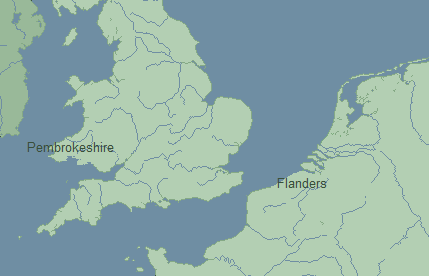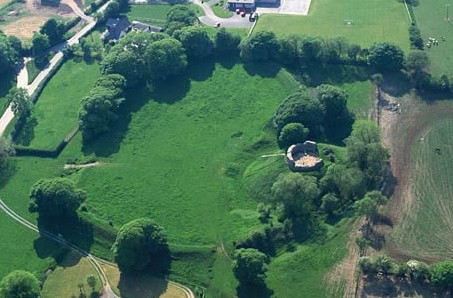
Wizo Flandrensis
ca. 1100 A.D.


nother account shows the name Wizo originating out of Flanders. Lord Wizo organizes a group of settlers into land granted by Henry I in South Pembrokeshire, England. The earliest mention of Castellum Wiz occurs in 1148. In Welsh the name becomes Castell Gwys. It is now known as Wiston Castle. The surrounding village appears as Wystune in 1319, now called Wiston.
 Wiston Castle is one of the finest examples of a motte and bailey stronghold to be found in Wales. It was established in the early years of the 12th century by a Flemish freebooter named Wizo. Encouraged by a deliberate policy of King Henry I of England (1100-35), Wizo had come to southern Pembrokeshire with a group of Flemish Colonists in search of lands and economic fortune. The castle and its adjacent borough represent a distinct aspect of the Norman colonization of Wales. At the end of the 11th century, Norman control of south-west Wales was anchored to a few isolated strongholds. There was every chance, as in the north-west of the country, that the ambition early displayed by the conquerors had outreached itself. From about 1105, however, King Henry I began to consolidate and expand the Norman authority by encouraging foreign colonists with grants of land which hitherto had been in Welsh hands. The most prominent group of these colonists in the Pembrokeshire region were the Flemings. It was one of their leaders, Wizo, �chieftain of the Flemings�, who established the castle, church, and borough at Wiston by 1112. Wizo was a locator - an entrepreneur - who put together groups of families to come to Wales and settle his new estates which he had been granted by the king. In due course, Wizo was to establish a second colony in Lanarkshire, Scotland. Wizo seems to have chosen an existing Iron Age enclosed settlement or rath as the basis for his castle. A large conical earthen motte was thrown up across the bank of the earlier settlement, and a gateway was created on the north-eastern side of the rath defences. The unusually large bailey of Wizo�s stronghold probably served to house the borough occupied by the first group of settlers. The prehistoric defences would have provided them with ready-made protection against the newly-dispossessed Welsh. As an earth and timber construction, the original Wiston may not have met the picture we may have of a typical medieval castle. It would, nevertheless, have been imposing and a symbol of Wizo�s new authority. (Turner). � |
10-05-2006
� |
'Notes on the Church and Parish of Rudbaxton'. Carmarthenshire FHS. 2000. Last retrived on October 03, 2006: http://www.rootsweb.com/~wlscfhs/rudbax1.htm. � |
� |
Remfry, Paul M. '1147 Wizo's Castle (Gwis/Wiz)'. The Castles of Wales. Last retrived on October 03, 2006: http://www.castlewales.com/remfry1.html. � |
� |
Thomas, Jeffrey L. 'Wiston Castle'. Cambrian Medieval Celtic Studies. Last retrived on October 03, 2006: http://www.castlewales.com/wiston.html. � |
� |
Toorians, Lauran. 'Wizo Flandrensis and the Flemish settlement in Pembrokeshire'. Castles of Wales. 20. 1990. pp. 99-118. |
� |
Turner, Rick. Wiston Castle. Cadw: Welsh Historic Monuments. June, 1996. |
� |
Williams, John Garnons. 'Wiston'. Wales at the Time of the Treaty of Montgomery 1267. Last retrived on October 03, 2006: http://www.gwp.enta.net/walhist.html. � |
� |
'Wiston Castle'. The Wogan Genealogy Site . Last retrived on October 03, 2006: http://www.wogan.info/Locations/wiston%20castle.htm. � |

� Home � Site Menu � Contact �

